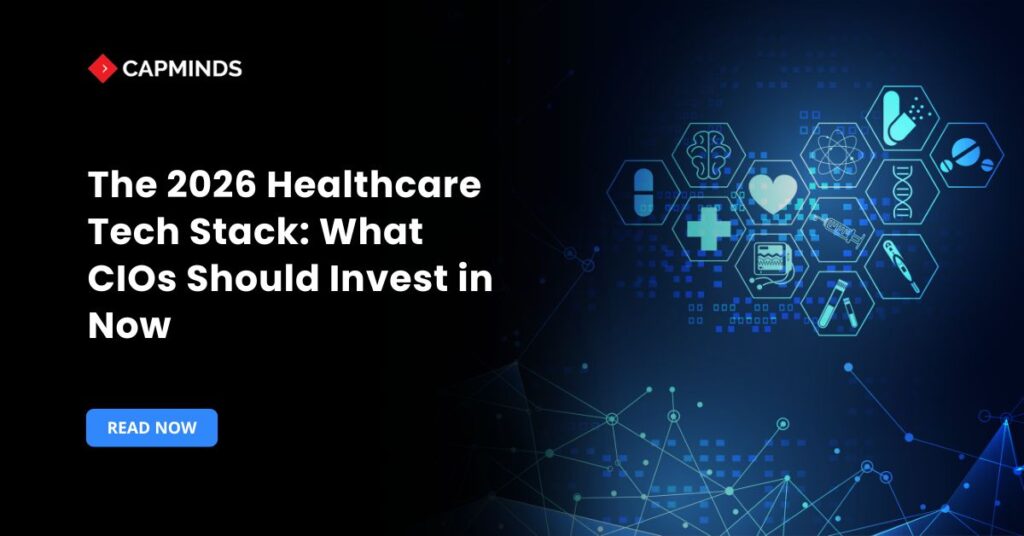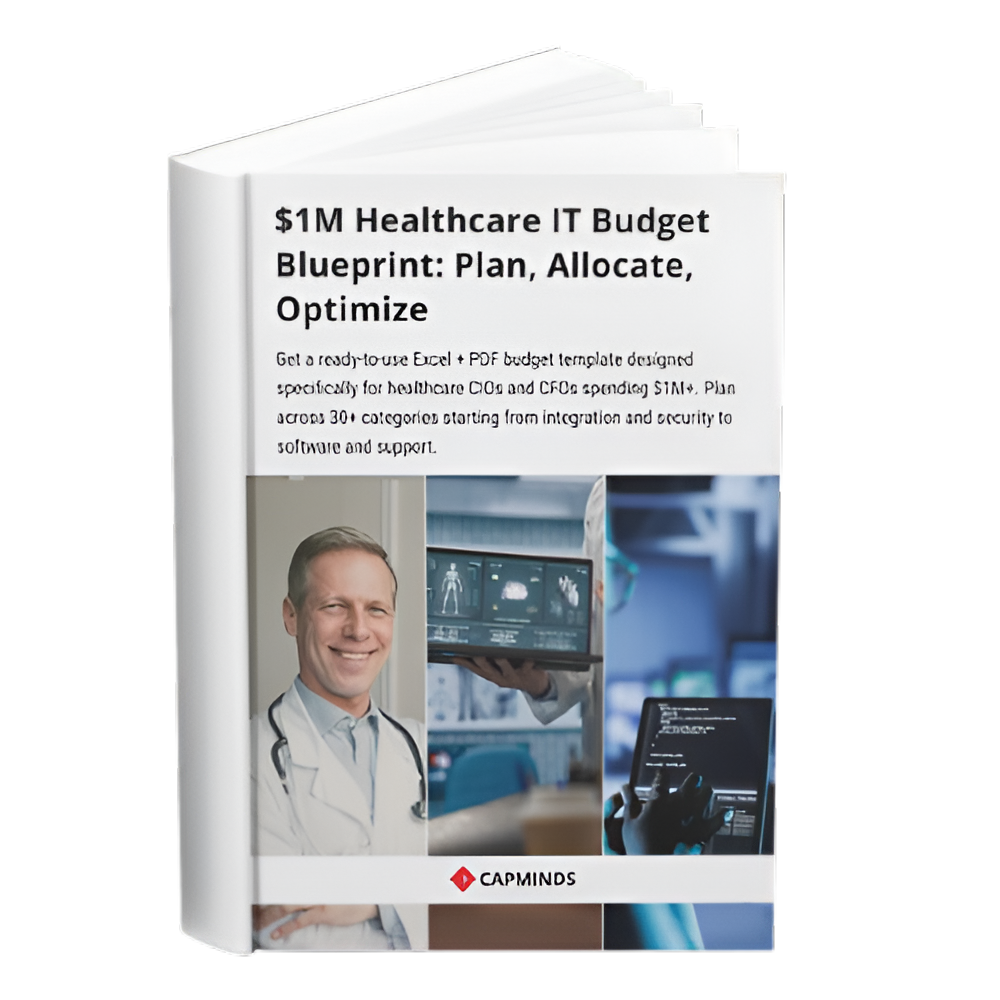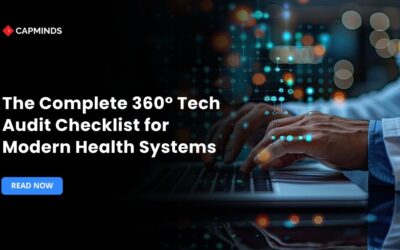The 2026 Healthcare Tech Stack: What CIOs Should Invest in Now
Hospital CIOs face a dynamic landscape of digital transformation, tight budgets, and rising patient expectations. By 2026, the foundation of care delivery will be built on integrated, platform-oriented technology stacks, not isolated point solutions. Leaders must therefore invest healthcare tech stack today in scalable, interoperable systems that power analytics, artificial intelligence, and secure data exchange.
According to recent surveys, health system IT executives uniformly rate AI/ML, cybersecurity, and workflow automation as top strategic priorities. In practice, this means consolidating systems, upgrading core platforms (often in the cloud), and embedding intelligence across the enterprise in order to improve outcomes and efficiency.
1. Cloud-First EHR and Clinical Platforms
Healthcare’s core systems are moving rapidly to the cloud. Leading EHR vendors now offer fully cloud-hosted solutions, and major health systems are migrating their patient data and applications off-premises.
- For example, New York’s Mount Sinai Health System is shifting its Epic EHR to Microsoft Azure, citing the benefits of scalability, anywhere access, and disaster recovery.
- As Mount Sinai’s CIO notes, “with Epic running on Azure, we can leverage the power of cloud to further optimize Epic operations and advance our capabilities…clinicians can access patient records from anywhere…and we can utilize machine learning to create predictive models that are integrated in Epic to support clinical care”.
- Similarly, Oracle Health has reimagined its ambulatory EHR as a cloud-native, AI-first platform.
- Built on Oracle Cloud Infrastructure, the new system is “voice-first” and agent-driven, allowing clinicians to use conversational voice commands to navigate charts and surface insights.
- Oracle plans to extend this cloud EHR into the acute care setting by 2026.
These developments reflect a broader trend: hospitals want to exit aging data centers and collapse infrastructure sprawl. As one CIO put it, a platform-centric strategy yields “numerous improvements with ease compared to coordinating myriad point solutions”.
In practice, investing in cloud-hosted clinical suites – whether it’s Epic on Azure/AWS or Oracle’s new agentic EHR – lays the groundwork for future innovations in AI, analytics, and care integration.
Related: Custom EHR Architecture in 2026: How to Build for Scalability, Interoperability, and Future Regulations
2. Artificial Intelligence and Machine Learning Everywhere
By 2026, AI/ML will be embedded in virtually every layer of the tech stack – from diagnostics to operations to patient experience. The pace of adoption is unprecedented: healthcare AI spending hit about $1.4 billion in 2024, roughly triple the prior year. Forward-looking health systems are already deploying AI broadly.
- For example, Kaiser Permanente implemented an ambient clinical documentation solution across 40 hospitals and 600+ clinics – the largest generative AI rollout in healthcare history.
- Advocate Health chose and went live on dozens of AI tools, including the largest deployment of Microsoft’s Dragon Medical One, plus imaging algorithms like Aidoc and Rad AI; these efforts are expected to cut physician documentation time by over 50% and automate workflows such as prior authorizations, referrals, and coding.
These examples show a clear shift: hospitals are moving from pilots to enterprise-scale AI deployments. AI’s applications are diverse: ambient scribing and voice AI are at the forefront, with vendors like Epic (in partnership with Microsoft) and startups like Abridge rolling out tools to automatically capture and draft clinical notes.
Other common use cases include virtual assistants for patient triage and follow-up, advanced imaging analytics (e.g., AI-assisted radiology and pathology), and predictive clinical decision support (warning of sepsis, readmissions, etc.). Health IT leaders note that workflow automation powered by AI – from voice documentation to intelligent scheduling – is as important as clinical AI.
Related: How AI & IoT Are Transforming Healthcare Apps (And How to Build One)
3. Interoperability and Data Exchange (FHIR, TEFCA, APIs)
Healthcare cannot become truly data-driven without seamless interoperability. New standards and policies are making this a core technology pillar. Fast Healthcare Interoperability Resources (FHIR) has emerged as the de facto API standard, and by late 2025, it is expected to enable widespread exchange for things like e-prescribing, prior auth, and population health metrics.
Major EHR vendors now publish comprehensive FHIR APIs: for example, the FHIR APIs allow patients and third-party apps to pull data from Epic, Cerner/Oracle, Meditech, etc., greatly simplifying integration.
- Policy momentum is also high: the new CMS “Health Technology Ecosystem” (2025) actively pushes hospitals, EHR vendors, payers, and patient-app developers to join connected networks and adhere to common standards.
- The stated vision is to “kill the clipboard” – for example, enable patients to maintain a digital health profile (scannable via QR code) and to automate data sharing across providers.
- In this model, certified networks (QHINs under TEFCA) must offer FHIR-based APIs and USCDI data at a minimum.
- It has connected 100% of eligible customers (including all federally qualified health centers) into TEFCA networks as of 2025 – illustrating that private vendors are racing to meet these expectations.
Strategic priority: Invest in the platforms and services that will be the glue of healthcare data. This includes enterprise API gateways, FHIR servers, patient identity/consent management, and cloud-based data exchanges. It also means aligning with federated networks (TEFCA QHINs) and implementing patient-facing portals or apps that can push/pull data via FHIR.
FHIR and TEFCA are not just compliance checkboxes – they are engines for digital transformation, clinical excellence, and patient engagement. Hospitals should treat these interoperability investments as enabling infrastructure for everything else (AI, analytics, care coordination), not as optional add-ons.
4. Cybersecurity and Zero-Trust Architecture
The flip side of all this connectivity and data sharing is heightened security risk. Healthcare IT leaders universally acknowledge that cybersecurity is non-negotiable. The scale of the threat is sobering: in 2024, over 275 million U.S. healthcare records were compromised – about 82% of the population – in largely preventable breaches. Approximately 80% of healthcare breaches now stem from hacking or ransomware, not “insider” errors.
Even well-funded hospitals are victims: large third-party incidents have spilled hundreds of millions of records at once. Given this environment, investing in a zero-trust security framework and other advanced defenses is imperative.
- Zero-trust means eliminating implicit trust everywhere: enforcing strong identity and multifactor authentication, micro-segmenting clinical and operational networks, and continuously verifying every user and device interaction.
- Healthcare-specific guidance now explicitly calls for moving away from flat VPN access to Zero Trust Network Access solutions and “just-in-time” privileged access controls.
- The aim is to require verification at every step – for example, only allowing a clinician’s login to see a patient’s chart if they are actively on the care team.
- As one security playbook notes, “every step toward Zero Trust materially reduces your risk of a catastrophic breach”.
This must be paired with continued investment in endpoint and cloud security, IoT device management, and threat intelligence. Nearly all hospitals now have large fleets of IoMT devices – including monitors, pumps, and wearables – many of which were designed with minimal security in mind.
Securing these devices is a critical part of the 2026 stack. In practice, CIOs should prioritize modern security platforms that simplify this complexity: unified monitoring, micro-segmentation, automated patching for medical devices, and robust incident response. It’s telling that in 2026 every hospital’s budget will guard cybersecurity as fiercely as any clinical project – not just to avoid breaches, but to meet tightening regulations and to preserve patient trust.
Related: The Zero Trust Blueprint for Healthcare IT 2025
5. Virtual Care, Hybrid Health, and the Digital Front Door
Telehealth is now routine, but the healthcare tech stack of 2026 goes beyond simple video visits. Leaders are building true hybrid care models: seamlessly integrating in-person and virtual channels along the entire care continuum. This means secure video platforms and remote monitoring devices at home, but also software to route patients to the right level of care. Key components include
- Tele-ICU programs
- Hospital-at-home platforms, and
- AI-driven triage bots.
Employers and payers also increasingly expect digital-first options for primary and behavioral care (see Amazon’s One Medical and virtual-first clinics). On the patient engagement side, the so-called “digital front door” is growing into an end-to-end engagement hub. Surveys show more than half of U.S. health systems have deployed some form of patient-facing digital portal or app, and 72% of health system executives cite improving digital consumer experience as a top priority for 2025.
Patients expect to do everything online: scheduling appointments, receiving test results, getting automated reminders, and even interacting with AI assistants (for example, chatbots that answer FAQs or coach chronic disease management). In fact, 73% of patients say access to electronic test results and messaging is a key part of a good experience.
CIOs should thus invest in integrated patient engagement platforms and services now. This might include upgraded patient portal software, chatbot frameworks (HIPAA-compliant virtual assistants), online check-in/registration tools, and cloud-based contact center solutions.
The payoff is tangible: one study showed that higher digital engagement correlates with faster billing and higher patient payment yields. Moreover, these digital channels can feed data back into the EHR and analytics systems, enhancing personalized care.
6. Analytics, Predictive Insights, and Decision Support
No 2026 tech stack is complete without a powerful data and analytics layer. Hospitals will need cloud data warehouses, real-time data lakes, and AI/ML frameworks to turn massive health data into actionable insights. In practice, this means investing in enterprise analytics platforms (often cloud-based) that integrate EHR, financial, and IoMT data.
Sharp HealthCare, for example, has already rolled out a “cloud-native analytics and AI stack” alongside its Epic system. These platforms enable predictive analytics for patient safety and operational efficiency.
- For example, by analyzing historical trends and live data, advanced models can forecast patient volumes, staffing needs, readmission risks, and clinical deterioration.
- Predictive tools may recommend when to order labs or imaging, or which patients need extra care coordination. In the operating room and ED, machine learning tools are used to predict case lengths and patient flow, optimizing scheduling and bed assignment.
- IT leaders should ensure they have the infrastructure (e.g., cloud BI tools, machine learning pipelines, governance) to develop or deploy these predictive models.
- As one expert wrote, “healthcare organizations that treat interoperability [and data] as a strategic asset” – building up data governance and analytics – will outpace others.
7. IoMT and Connected Health Infrastructure
Finally, building connected infrastructure is essential. The Internet of Medical Things (IoMT) – from implanted sensors and wearables to smart infusion pumps and facility-wide sensors – is exploding. One forecast projects the global IoMT market approaching $245 billion by 2029, driven by home monitoring and 5G-enabled hospital networks. Major industry players (Medtronic, Philips, GE HealthCare, Siemens, Qualcomm, etc.) are investing heavily in smart devices and platforms. By 2026, hospitals will routinely use continuous glucose monitors, cardiac monitors, and other wireless devices as standard of care, generating streams of real-time data.
CIOs must therefore build the network and management layers to support this growth. This means high-density Wi-Fi/5G in facilities, edge computing gateways, and unified device management platforms that can discover, monitor, and update thousands of IoMT devices. It also means robust security and compliance for these devices (many have limited built-in protection). Already, regulations are emerging: the FDA is tightening cybersecurity requirements for device makers, and new state and federal rules mandate swift breach reporting.
From a strategic standpoint, investing in an IoT infrastructure – including middleware that ingests sensor data and connects it to the EHR/analytics systems – will unlock new capabilities like remote patient monitoring (RPM) and predictive maintenance of equipment. For example, during the COVID era, many systems piloted remote patient monitoring programs (for chronic illness or post-discharge care) that relied on wearable devices and cloud dashboards. Those pilots are now scaling up; a modern EMR should integrate those data feeds rather than treating them as siloed “apps.”
CapMinds Healthcare Technology Services: Powering Your 2026-Ready Digital Health Stack
As hospitals move toward cloud-first systems, AI-enabled workflows, advanced interoperability, and connected care infrastructure, the right Health Tech Service Partner becomes mission-critical. CapMinds provides end-to-end Healthcare Technology Services that help CIOs modernize confidently, accelerate digital transformation, and build a unified, future-proof 2026 tech stack.
With our full-suite digital health engineering, implementation, and integration services, your hospital can streamline operations, strengthen security, and unlock scalable innovation.
Our Key Services for a 2026-Ready Tech Stack:
- EHR Modernization & Cloud Migration Services (Epic, Cerner/Oracle, Meditech, OpenEMR)
- AI/ML Engineering & Workflow Automation Services
- FHIR, TEFCA & API Integration Services
- Zero-Trust Cybersecurity & Compliance Services
- Telehealth, RPM & Hybrid Care Enablement Services
- IoMT, Device Integration & Connected Infrastructure Services
- Enterprise Analytics, Data Engineering & Predictive Insights Services
From cloud transformation to AI deployment and interoperability engineering, CapMinds helps you consolidate systems, reduce complexity, and improve clinical efficiency, all with a secure, scalable, service-driven approach.
Build your 2026 healthcare ecosystem with confidence. Partner with CapMinds today.




